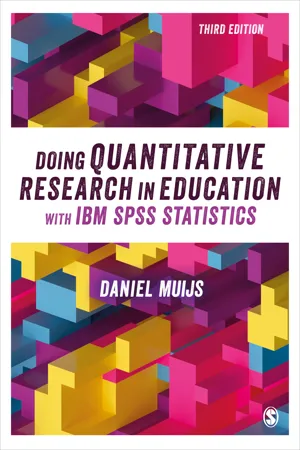
- 232 pages
- English
- ePUB (mobile friendly)
- Available on iOS & Android
eBook - ePub
Doing Quantitative Research in Education with IBM SPSS Statistics
About this book
This essential guide for education students and researchers explains how to use quantitative methods for analysing educational data using IBM SPSS Statistics.
By using datasets from real-life educational research, it demonstrates key statistical techniques that you will need to know, explaining how each procedure can by run on IBM SPSS Statistics. Datasets discussed in the book are downloadable, allowing you to hone your skills as you read.
In this third edition, explanations have been updated with figures and screenshots from SPSS version 28, alongside a range of new research examples and updated further reading.
Daniel Muijs is Dean of the Faculty of Education and Society at Academica University of Applied Sciences in Amsterdam.
By using datasets from real-life educational research, it demonstrates key statistical techniques that you will need to know, explaining how each procedure can by run on IBM SPSS Statistics. Datasets discussed in the book are downloadable, allowing you to hone your skills as you read.
In this third edition, explanations have been updated with figures and screenshots from SPSS version 28, alongside a range of new research examples and updated further reading.
Daniel Muijs is Dean of the Faculty of Education and Society at Academica University of Applied Sciences in Amsterdam.
Frequently asked questions
Yes, you can cancel anytime from the Subscription tab in your account settings on the Perlego website. Your subscription will stay active until the end of your current billing period. Learn how to cancel your subscription.
At the moment all of our mobile-responsive ePub books are available to download via the app. Most of our PDFs are also available to download and we're working on making the final remaining ones downloadable now. Learn more here.
Perlego offers two plans: Essential and Complete
- Essential is ideal for learners and professionals who enjoy exploring a wide range of subjects. Access the Essential Library with 800,000+ trusted titles and best-sellers across business, personal growth, and the humanities. Includes unlimited reading time and Standard Read Aloud voice.
- Complete: Perfect for advanced learners and researchers needing full, unrestricted access. Unlock 1.4M+ books across hundreds of subjects, including academic and specialized titles. The Complete Plan also includes advanced features like Premium Read Aloud and Research Assistant.
We are an online textbook subscription service, where you can get access to an entire online library for less than the price of a single book per month. With over 1 million books across 1000+ topics, we’ve got you covered! Learn more here.
Look out for the read-aloud symbol on your next book to see if you can listen to it. The read-aloud tool reads text aloud for you, highlighting the text as it is being read. You can pause it, speed it up and slow it down. Learn more here.
Yes! You can use the Perlego app on both iOS or Android devices to read anytime, anywhere — even offline. Perfect for commutes or when you’re on the go.
Please note we cannot support devices running on iOS 13 and Android 7 or earlier. Learn more about using the app.
Please note we cannot support devices running on iOS 13 and Android 7 or earlier. Learn more about using the app.
Yes, you can access Doing Quantitative Research in Education with IBM SPSS Statistics by Daniel Muijs in PDF and/or ePUB format, as well as other popular books in Education & Education Theory & Practice. We have over one million books available in our catalogue for you to explore.
Information
Table of contents
- Cover
- Half Title
- Publisher Note
- Title Page
- Copyright Page
- Contents
- Illustration List
- Table List
- About the author
- New to this edition
- Preface
- Acknowledgements
- 1 Introduction to quantitative research
- 2 Experimental and quasi-experimental research
- 3 Designing non-experimental studies
- 4 Validity, reliability and generalisability
- 5 Introduction to IBM SPSS Statistics and the data set
- 6 Univariate statistics
- 7 Bivariate analysis: comparing two groups
- 8 Bivariate analysis: looking at the relationship between two variables
- 9 Multivariate analysis: using regression models to look at the relationship between several predictors and one dependent variable
- 10 Using analysis of variance to compare more than two groups
- 11 Developing scales and measures: item and factor analysis
- 12 One step beyond: introduction to multilevel modelling and structural equation modelling
- References
- Index